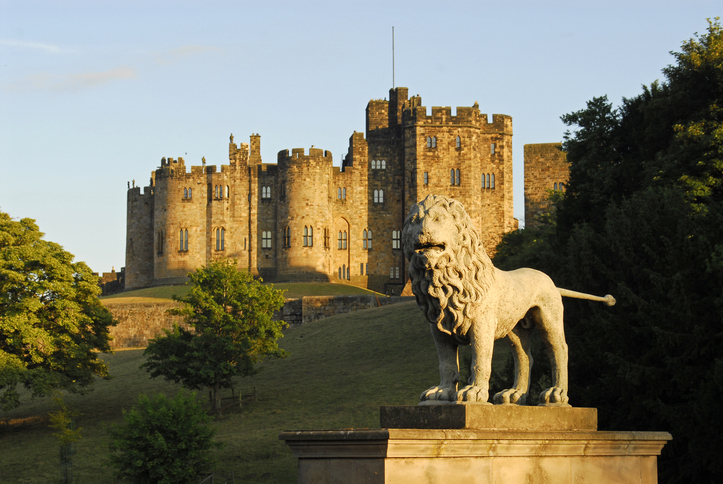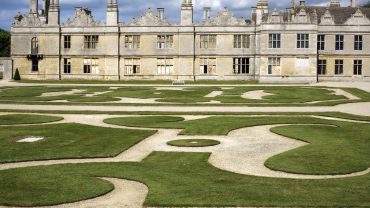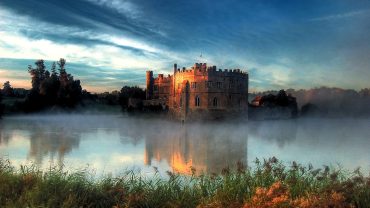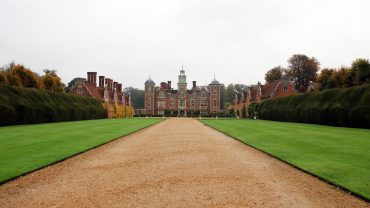Throughout their history, the most famous UK castles have been witness to countless dramatic events, from epic battles and bloody rebellions, to clandestine plots, and royal intrigue. These imposing structures have played pivotal roles in shaping the nation’s history, serving as centres of power, symbols of authority, and focal points for both glory and misfortune. Yet the UK’s most famous castles also hosted jousts, feasts, and grand ceremonies that captured the hearts and imaginations of all who attended. Their thick walls have witnessed every shade of human emotion – love, betrayal, victory, and tragic downfall.
Including standing structures and ruins, there are around 4,000 castles in the UK, and here, we’ll lay siege to some of the most famous castles in Britain.
A Short History of British Castles

Beaumaris Castle in North Wales (Credit: theasis via Getty Images)
The history of fortifications in the United Kingdom stretches back millennia, with the earliest defensive structures dating to the Bronze and Iron Ages. These ancient hillforts were built on high ground and consisted of a series of ramparts and ditches designed to protect against warring tribes and invaders. These early fortifications laid the groundwork for the more elaborate and iconic UK castles that would come to dominate the British landscape in later centuries.
The Norman Conquest
The Norman Conquest of 1066 marked a turning point in the evolution of castles in Britain. William the Conqueror introduced a new era of castle construction, initially building motte-and-bailey castles – wooden or stone keeps set on artificial mounds surrounded by enclosed courtyards. These structures were strategically placed to control population centres, road networks, and key defensive positions. Over time, castle design evolved to include more sophisticated stone fortifications, with Windsor Castle, one of the UK’s most famous castles which was begun around 1070, standing as one of the oldest and most iconic examples of Norman castle architecture.
Medieval Castle Design
Castle design continued to evolve throughout the medieval period. In the twelfth and thirteenth centuries, stone became the predominant building material, replacing earlier wooden structures. This shift allowed for more elaborate and durable fortifications including the iconic UK castles of Barnard Castle in County Durham, Framlingham Castle in Suffolk, and Lincoln Castle in Lincolnshire. Keeps became larger and more sophisticated, and the development of stone vaulting techniques enabled masons to create more spacious interiors without compromising structural integrity.
Adaptability
As military technology advanced, castle designs adapted to meet new threats. Curtain walls grew taller and thicker, while gatehouses became increasingly complex, featuring multiple defensive layers. The introduction of concentric castle designs, with multiple rings of walls – most notably the famous UK castles of Beaumaris and Caerphilly in Wales, and Dover Castle in Kent – provided enhanced protection. By the late medieval period, castles began to incorporate more residential features, balancing defensive capabilities with comfort and luxury. This trend culminated in the grand fortified palaces of the fifteenth and sixteenth centuries, like Herstmonceux Castle in East Sussex and Thornbury Castle in Gloucestershire, which showcased both military strength and aristocratic opulence.
So without further ado, let’s storm the gates of history and take a look at some of the most famous castles in Britain.
Windsor Castle, Berkshire

Windsor Castle, one of the world's oldest and most famous fortresses (Credit: chrisho via Getty Images)
Founded by William the Conqueror in the eleventh century, Windsor Castle is home to a thousand years of British royal history. Originally constructed as a motte-and-bailey fortress to guard the western and south-western approaches to London, from the reign of Henry I (1100 – 1135), the castle has been continuously inhabited and modified, making it the oldest and largest occupied castle in the world. From its Norman foundations to Gothic additions and Baroque embellishments, Windsor Castle is perhaps the most famous UK castle and is home to the iconic Round Tower and the stunning St. George’s Chapel. It remains a royal residence, and attracts visitors from all over the world with its rich history and architectural grandeur.
Edinburgh Castle, Scotland

Edinburgh Castle from Princes Street Gardens (Credit: godrick via Getty Images)
Edinburgh Castle is a legendary symbol of Scotland’s rich history and one of the most iconic UK castles. Built in the twelfth century by King David I on the site of earlier fortresses, the castle has been a royal residence, military stronghold, and national monument for over 900 years. Its strategic location on top of Castle Rock has made it a formidable fortress throughout the centuries. The castle’s architecture spans multiple periods, from the twelfth-century St. Margaret’s Chapel, the oldest surviving building in Edinburgh, to the sixteenth-century Great Hall. Edinburgh Castle is Scotland’s most-visited tourist attraction, offering visitors a glimpse into the nation’s turbulent past and its enduring royal legacy.
Conwy Castle, Wales

Conwy Castle in North Wales (Credit: Peter Groenendijk via Getty Images)
Conwy Castle, one of the most famous UK castles, is an iconic fortress in North Wales, and was built using local limestone and sandstone between 1283 and 1287 by King Edward I as part of his campaign to dominate Wales. The castle stands on a coastal ridge overlooking the Conwy estuary, providing strategic control over the region and is part of Edward’s ‘Iron Ring of Castles’ which included Beaumaris, Harlech, and Caernarfon. The castle’s impressive defences include eight huge round towers, each standing twenty-one metres tall, and thick curtain walls. Its main entrance, protected by a barbican, features the earliest surviving stone machicolations in Britain. It’s a UNESCO World Heritage Site, and one of Europe’s finest examples of late thirteenth century military architecture.
Warwick Castle, Warwickshire

Warwick Castle, with its reflection in the River Avon (Credit: prestongeorge via Getty Images)
One the most picturesque castles in Britain, Warwick Castle boasts a history spanning nearly a thousand years. Founded by William the Conqueror in 1068 as a motte-and-bailey castle, it was strategically built on a sandstone bluff overlooking a bend in the River Avon. Initially constructed of wood, it was rebuilt in stone during the twelfth century and has evolved from a military stronghold into a magnificent stately home. Its impressive features include Caesar’s Tower and Guy’s Tower, both added in the fourteenth century. The castle’s architecture blends Norman and Gothic styles, showcasing grand halls, state rooms, and formidable defences. Today, Warwick Castle is a popular tourist attraction, where visitors can immerse themselves in England’s rich medieval history.
Leeds Castle, Kent

The beauty of Leeds Castle in Kent (Credit: clubfoto via Getty Images)
Often described as ‘the loveliest castle in England’, Leeds Castle is one of the most famous castles in Britain and has a rich history spanning over nine centuries. Rebuilt from a Saxon wooden structure in 1119 by Robert de Crevecoeur as a Norman stronghold, it became a royal castle in 1278 when it was bought by Eleanor of Castille, the queen of King Edward I. The castle has served as a residence for a number of medieval queens and was transformed by Henry VIII into a splendid palace for his first wife, Catherine of Aragon, in 1519. Its strategic location on two islands in a lake formed by the River Len provided natural defences. The castle’s architecture reflects various periods, including Norman, Gothic, and Tudor styles. It has been in private hands since the late sixteenth century, and the last owner, American heiress Olive, Lady Baillie, who bought it for £180,000 in 1926, left it to a charitable trust when she died in 1974. It has been open to the public since 1976.
Alnwick Castle, Northumberland

Alnwick Castle and the Lions Bridge (Credit: darrenturner via Getty Images)
Perhaps best-known as a filming location for a number of the Harry Potter films and the original series of Blackadder, Alnwick Castle, one of the UK’s most famous castles, has been the seat of the Dukes of Northumberland since 1309 and is the second-largest inhabited castle in England after Windsor Castle. Founded in 1096 by French nobleman Ivo de Vesci, the castle’s strategic location guarding a road crossing the River Aln made it a crucial stronghold in England’s defence against Scottish invasions. Its architecture evolved over centuries, and some of the most notable features include the imposing Norman keep, the fourteenth-century octagonal towers flanking the entrance, and the intricate network of serpentine walls and courtyards. In the eighteenth and nineteenth centuries, the castle was transformed from a military fortress into a grand stately home.
Dunluce Castle, Northern Ireland

The ruins of Dunluce Castle in Northern Ireland (Credit: Robert Louden via Getty Images)
Situated on a dramatic basalt outcropping along Northern Ireland’s Causeway Coast between Portballintrae and Portrush, Dunluce Castle was said to be built in the thirteenth century by Richard Óg de Burgh, 2nd Earl of Ulster, however the earliest reliable documentary references to a stone castle on this site date from the sixteenth century when it was held by the McQuillans, then the MacDonnells. The castle’s architecture features two large drum towers and a complex layout with tunnels, footbridges, and cobbled streets, showcasing a blend of late medieval and Renaissance styles. Dunluce, one of the most famous UK castles, served as the seat of the Earls of Antrim until the family’s fortunes declined following the Battle of the Boyne in 1690, after which it fell into ruin. Today, the castle is most well-known for its stunning coastal setting and its role as the fictional House Greyjoy in the Game of Thrones series.
Corfe Castle, Dorset

Corfe Castle at sunrise (Credit: Southern Lightscapes-Australia via Getty Images)
Corfe Castle in Dorset is one of England’s most iconic medieval fortresses. Originally built by William the Conqueror in the eleventh century, it was among the earliest Norman castles to incorporate stone construction, highlighting its strategic importance. The castle’s design includes three main enclosed areas – the outer bailey, west bailey, and inner ward, each at successively higher levels. Over the centuries, Corfe Castle evolved from a timber fort to a formidable stone stronghold – one of England’s greatest – with significant expansions during the reign of King Henry I. It played a pivotal role in English history, including a notable siege during King Stephen’s reign and its association with the alleged murder of King Edward the Martyr. It was eventually slighted in 1645 during the English Civil War. Today, one of the most famous castles in Britain stands as a picturesque ruin that gives visitors a look into centuries of English history.
Caernarfon Castle, Wales

Caernarfon Castle, a UNESCO World Heritage Site (Credit: eyewave via Getty Images)
Among the most impressive medieval fortresses in Britain is Caernarfon Castle, situated on the banks of the River Seiont in northwest Wales. Originally built on the site of a Roman fort by Norman lords loyal to William the Conqueror in the late eleventh century, it was extensively rebuilt and expanded by King Edward I between 1283 and 1330 as part of his Iron Ring of castles to control Wales. The castle features distinctive polygonal towers and banded coloured stonework, setting it apart from other Edwardian castles, and its unique architecture is thought to be inspired by the walls of Constantinople. Notable features include the imposing Eagle Tower, and the formidable King’s Gate with its complex defensive system. Caernarfon Castle is a UNESCO World Heritage site, and one of the most iconic UK castles. It was also the location of the investiture of the Prince of Wales, now HRH King Charles III, in 1969.
Arundel Castle, West Sussex

Spring flowers surrounding Arundel Castle in West Sussex (Credit: Traveladventure via Getty Images)
A beautiful edifice located in the West Sussex countryside, Arundel Castle was originally established in 1068 by Roger de Montgomery, a loyal ally of William the Conqueror. It began as a motte-and-bailey structure with a timber keep, and over the centuries, it was transformed into a formidable stone fortress, with its iconic Norman keep built in the twelfth century and later additions reflecting Gothic and Victorian styles. One of the most famous UK castles, it served as the ancestral seat of the Earls of Arundel and the Dukes of Norfolk for over 850 years and played a significant role in English history, including surviving sieges during the Civil War, and welcoming Queen Victoria and Prince Albert in the 1840s.
Tower of London, London

The world-famous Tower of London from the River Thames (Credit: Luis Diaz Devesa via Getty Images)
The Tower of London, one of England’s – and the world’s – most iconic landmarks, was founded by William the Conqueror in 1078 as a symbol of Norman power and authority. Its crowning glory, the White Tower, is a classic Norman stone keep and one of the oldest surviving structures of its kind. Over the centuries, successive monarchs (most notably Richard I, Henry III and Edward I) expanded the castle, creating a concentric fortress with two layers of defensive walls and a moat, the latter adding the outer curtain wall and the infamous Traitors’ Gate. The Tower has served many roles throughout history, including a royal residence and treasury. It was a prison from 1100 until 1952 and, along with Tower Hill, the execution site of such luminaries as Anne Boleyn, Catherine Howard, Lady Jane Grey, Thomas Cromwell and Sir Walter Raleigh. Today, it is a UNESCO World Heritage Site and home to the Crown Jewels, drawing millions of visitors every year to explore its rich and turbulent history.











